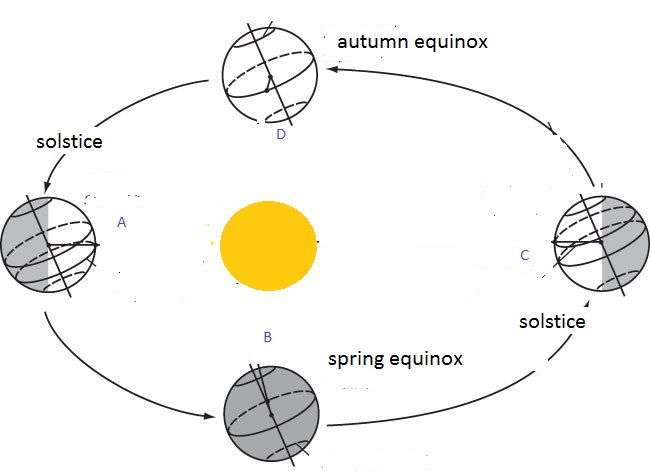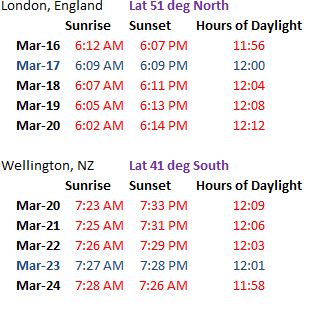Now that we are in the month of March, it is only a short time until 21 March, the first day of spring (or first day of autumn if you’re one of my readers in the southern hemisphere).
There is a commonly held view that 21 March is an equinox and that the equinoxes are the two days in the year when all places on the Earth have exactly 12 hours of daylight and 12 hours of darkness. In fact, as I’ll explain later, both these statements are only approximately correct. In reality the situation is as follows.
- 21 March can sometimes be the date on which the spring equinox falls but its date varies from year to year and also depends upon where you are located. In 2018 it will fall on 20 March for most places in the world.
- At the equinoxes there is actually nowhere on the Earth where there are exactly 12 hours of daylight and 12 hours of darkness.
What is an equinox?
The origin of the word equinox comes from two Latin words aequus (equal) and nox (night). This definition suggests that at an equinox the length of the day and night are equal. However the precise astronomical definition of an equinox is slightly different.
The diagram above shows the Earth going around the Sun in its orbit
- At the December solstice (point A in the diagram) the North Pole is tilted further away from the Sun than at any other time of the year, and the South Pole is tilted nearest the Sun. In the northern hemisphere the period of darkness is longest compared with the period of daylight, and in the southern hemisphere the reverse applies.
- At the summer solstice in June (point C) it is exactly the opposite of the winter solstice – it is the North Pole which is now tilted nearest to the Sun so the northern hemisphere experiences the longest period of daylight.
- There are two times a year (B and D in the diagram) when the neither the North Pole nor the South Pole are tilted towards the Sun and these times are the equinoxes. If we take two places with the same latitude, one of which is North of the equator and the other one South of the equator, (for example Istanbul, Turkey 41oN and Wellington New Zealand 41oS ) they will both have the same amount of daylight at the equinox.
On what date do the equinoxes occur?
The diagram also shows that the Earth moves in an elliptical orbit around the Sun. This means that it has further to travel in its orbit between the March equinox and the September equinox than in the return leg of its journey from September to March. The two equinoxes are therefore not exactly half a year apart: from the March equinox to the September equinox is around 186 days, whereas from the September equinox to the March equinox is only 179 days.
The tables below give the times of the two equinoxes from 2016 to 2021 for three Locations: London (Greenwich Mean Time or GMT), Honolulu (GMT -10 hours) and Tokyo (GMT +9 hours). As you can see, the northern hemisphere spring equinox can occur on 19, 20 or 21 March and the autumn equinox on 22 or 23 September.
(Data TimeandDate.com 2016a)
On what dates in a year are there are exactly 12 hours of daylight?
The first thing we need to think about when we answer this question is what do we mean by the word ‘daylight’? Do we consider twilight, the time just after sunrise or just before sunset when it is not completely dark, to be daylight? Or do we consider daylight as being the time when the Sun is above the horizon?
If we use the definition of ‘daylight’ as being the interval between sunrise and sunset then there are actually slightly more than 12 hours of daylight at the equinox everywhere in the world. The first reason for this is that the definition of sunrise is the time when the first light from the Sun’s rays reaches above the horizon, not when the centre of the Sun is above the horizon. The diagram below shows the path of the Sun’s disc around sunrise at the equinox in London. In the early morning, the time when the half of the Sun is above the horizon and half below the horizon is 6:03 am, shown as B in the diagram, but sunrise is about a minute before this time.
Similarly, in the early evening the time when half of the Sun is above the horizon and half below the horizon is 6:13 pm, B in the diagram, but sunset is when the last light from the Sun’s rays are above the horizon and is about a minute after this time.
The second reason for there being more than 12 hours of daylight at the equinox is that when the Sun is just below the horizon the Earth’s atmosphere bends the Sun’s rays, causing it to appear just above the horizon. This bending of light is known as refraction and has the effect of slightly extending the hours of daylight.
Taken together, these two effects mean that there are slightly more than 12 hours of daylight at the equinox. The table below shows the amount of daylight for dates around the equinox in London and Wellington. It shows that the date on which there are exactly 12 hours of daylight and 12 hours of darkness in London is 17 March, three days earlier but in Wellington it is 3 days later on 23 March.
(TimeandDate.com 2016b)
References
TimeandDate.com (2016) Solstices & Equinoxes for London (Surrounding 10 Years). Available at: http://www.timeanddate.com/calendar/seasons.html?n=136 (Accessed: 5 March 2016).
TimeandDate.com (2016) London, ENG, United Kingdom — Sunrise, Sunset, and Daylength, March 2016, Available at: http://www.timeanddate.com/sun/uk/london(Accessed: 1 March 2016).








[…] are two fascinating options of this definition. The primary one is that as mentioned in a previous post the precise date of the spring equinox isn’t at all times March 21. It varies from 12 months to […]
LikeLike
[…] are two fascinating options of this definition. The primary one is that as mentioned in a previous post the precise date of the spring equinox isn’t at all times March 21. It varies from 12 months to […]
LikeLike
[…] are two interesting features of this definition. The first one is that as discussed in a previous post the exact date of the spring equinox isn’t always March 21. It varies from year to year and also […]
LikeLike
[…] are two interesting features of this definition. The first one is that as discussed in a previous post the exact date of the spring equinox isn’t always March 21. It varies from year to year and […]
LikeLike
[…] Source link […]
LikeLike
[…] however, you’ll have to wait until 2158. For an explanation of this variability, you should browse the Science Geek website where this (and a lot more) is explained in plain language with fine […]
LikeLike
I love the science. 😀 … still, there’s something magical about the time anyway. 😀
LikeLiked by 1 person
Yes definitely
LikeLiked by 1 person
[…] The Science Geek […]
LikeLike
Equal hours or not, I’m hoping it’ll be warmer. Haven’t managed to have breakfast on patio this year!
LikeLiked by 1 person
Yes it has certainly been rather chilly in the last week !
LikeLike
Just have a hot spring roll with chilly sauce 🙂
LikeLike
🙂
LikeLike
Nice one 🙂
Looking forward to the 17th of March when I can tell everybody that the day and night are equal
LikeLiked by 1 person